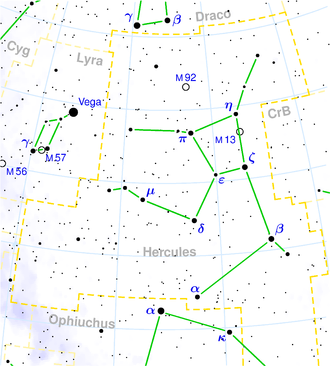NGC 6160
| Galaxy NGC 6160 |
|
|---|---|

|
|
| NGC 6160 with LEDA 214500 (l) SDSS image | |
| AladinLite | |
| Constellation | Hercules |
|
Position equinox : J2000.0 , epoch : J2000.0 |
|
| Right ascension | 16 h 27 m 41.1 s |
| declination | + 40 ° 55 ′ 38 ″ |
| Appearance | |
| Morphological type | cD / E2 |
| Brightness (visual) | 13.3 mag |
| Brightness (B-band) | 14.3 mag |
| Angular expansion | 1.8 ′ × 1.5 ′ |
| Position angle | 65 ° |
| Surface brightness | 14.4 mag / arcmin² |
| Physical data | |
| Affiliation | Abell 2197 |
| Redshift | 0.031765 ± 0.000070 |
| Radial velocity | (9523 ± 21) km / s |
|
Stroke distance v rad / H 0 |
(432 ± 30) · 10 6 ly (132.6 ± 9.3) Mpc |
| history | |
| discovery | Wilhelm Herschel |
| Discovery date | March 18, 1787 |
| Catalog names | |
| NGC 6160 • UGC 10400 • PGC 58191 • 58199 • CGCG 224-032 • MCG + 07-34-042 • 2MASX J16274107 + 4055368 • GC 4204 • H II 652 • h 1960 • | |
NGC 6160 is a 13.3 mag bright cD galaxy of the Hubble type E2 in the constellation Hercules in the northern sky . It is estimated to be 432 million light years from the Milky Way and about 230,000 light years across.
In the same area of the sky are u. a. the galaxies NGC 6146 , NGC 6150 , NGC 6173 , NGC 6174 .
The object was discovered on March 18, 1787 by Wilhelm Herschel with an 18.7-inch reflector telescope, who described it as "vF, S, R, lbM, easily resolvable, near some small stars".
